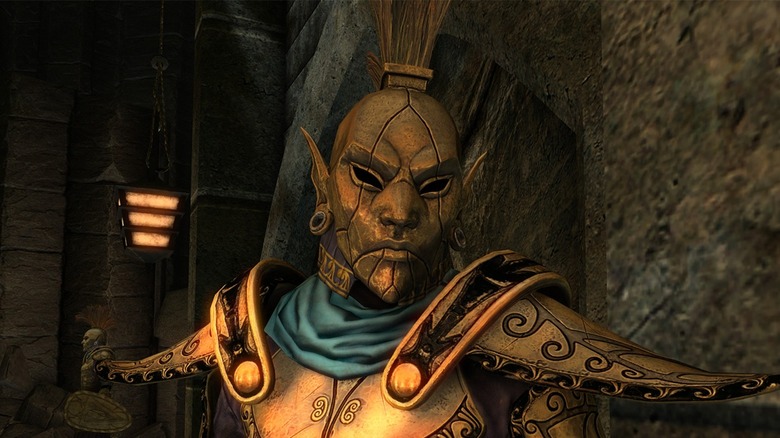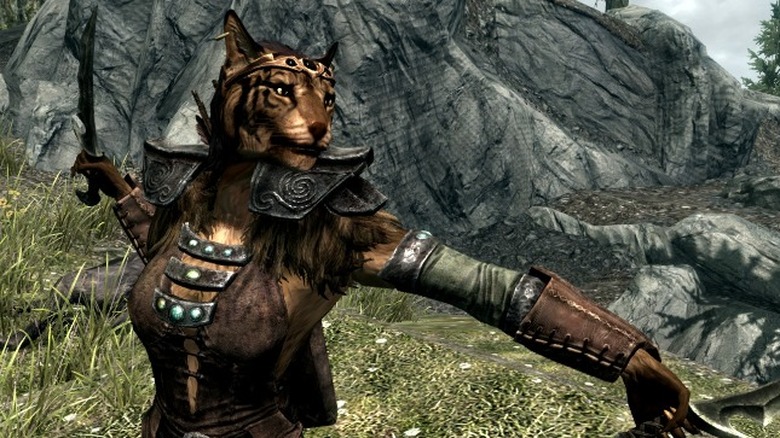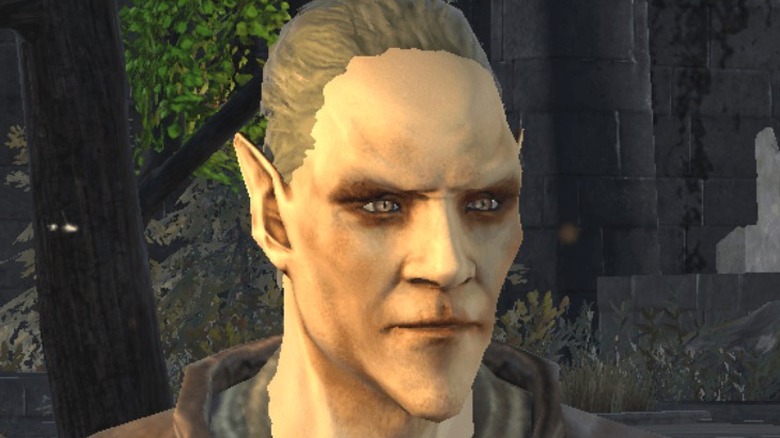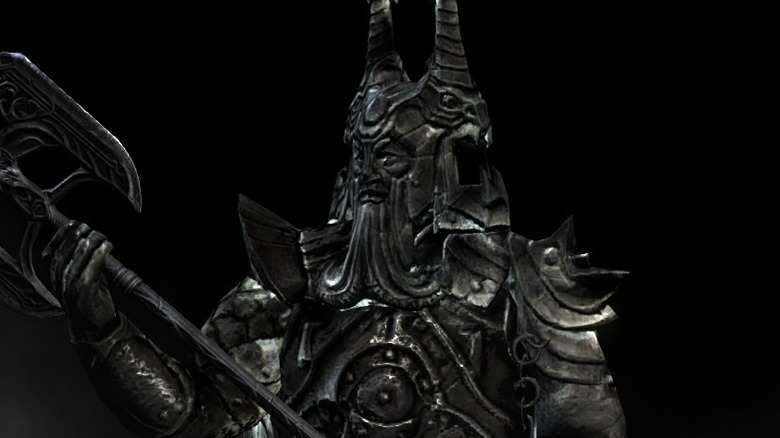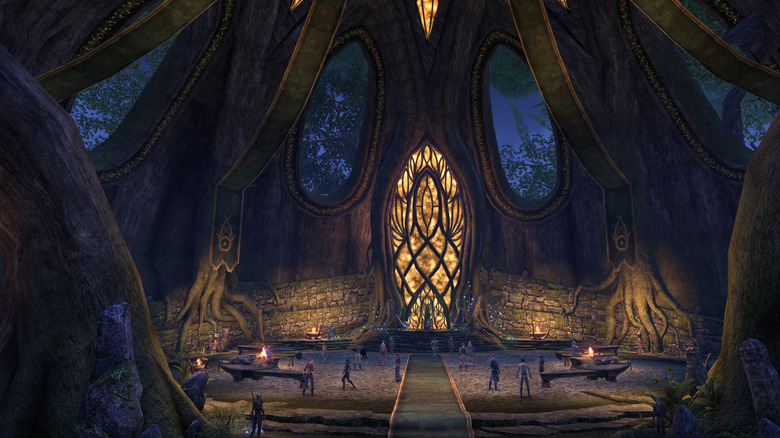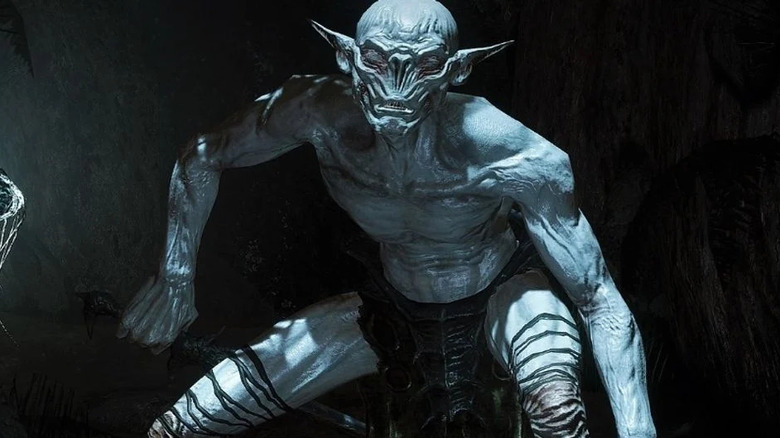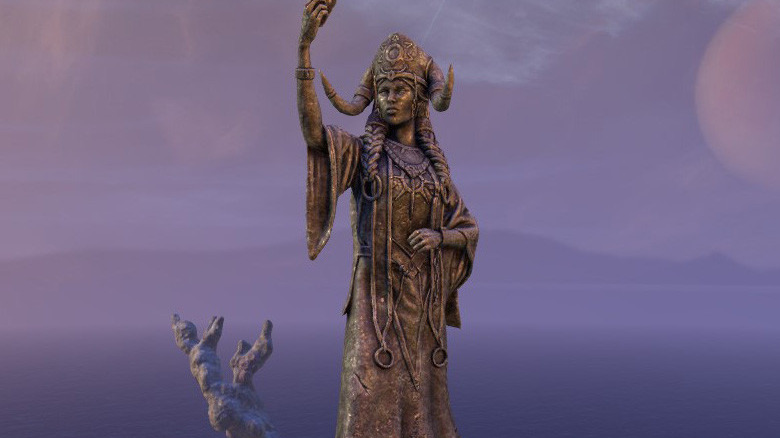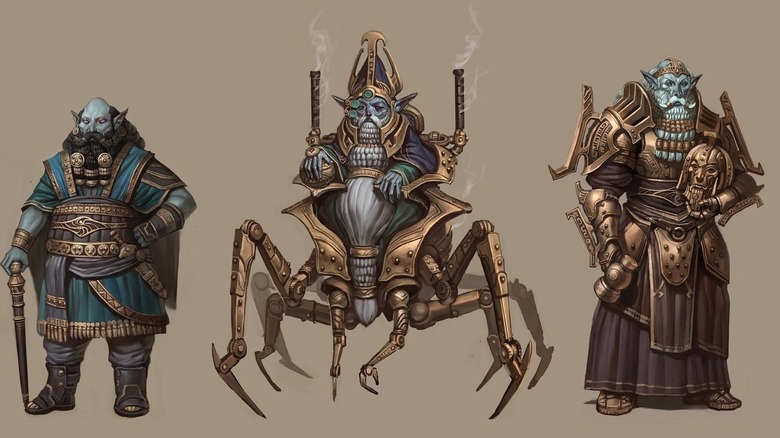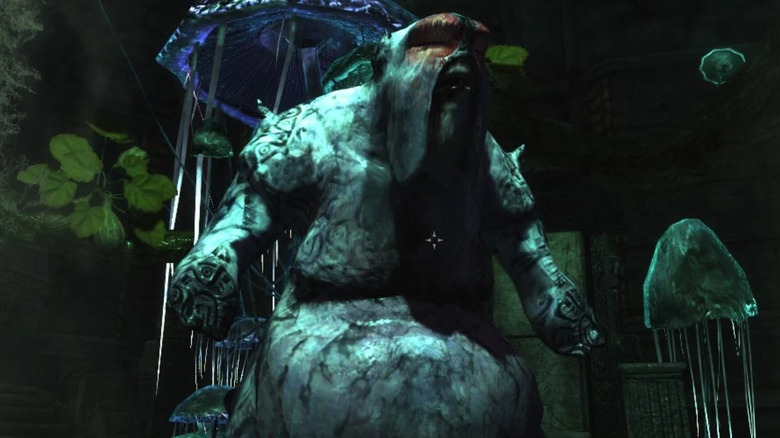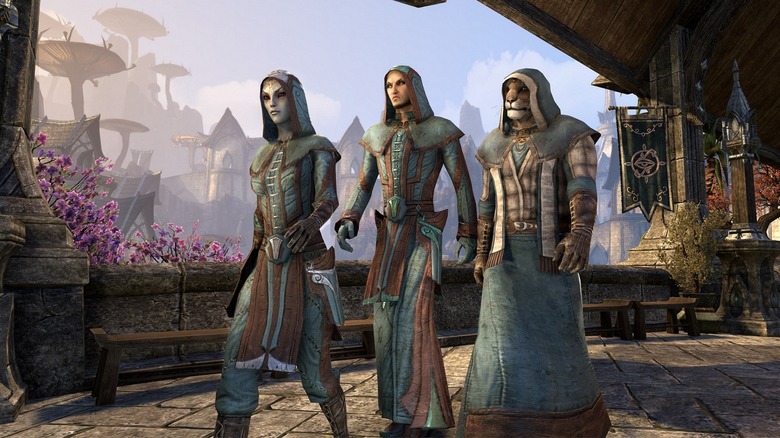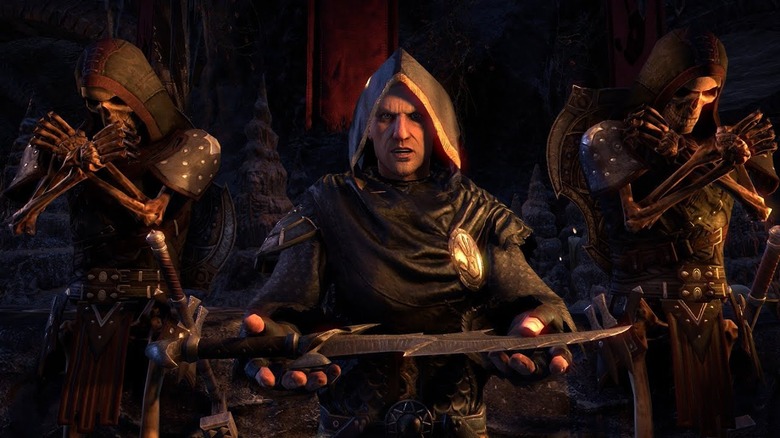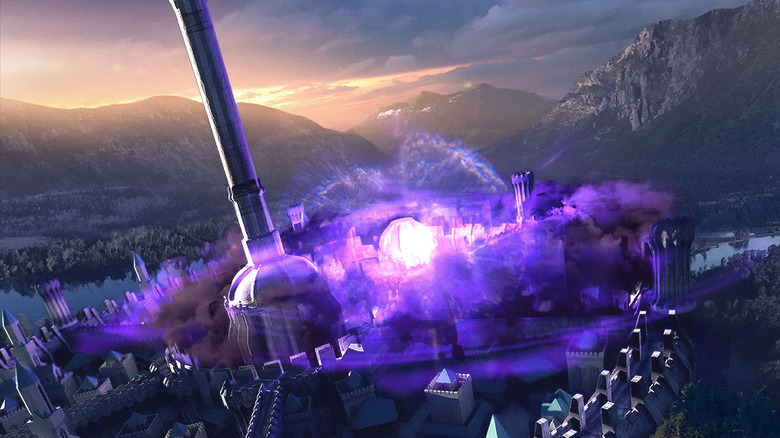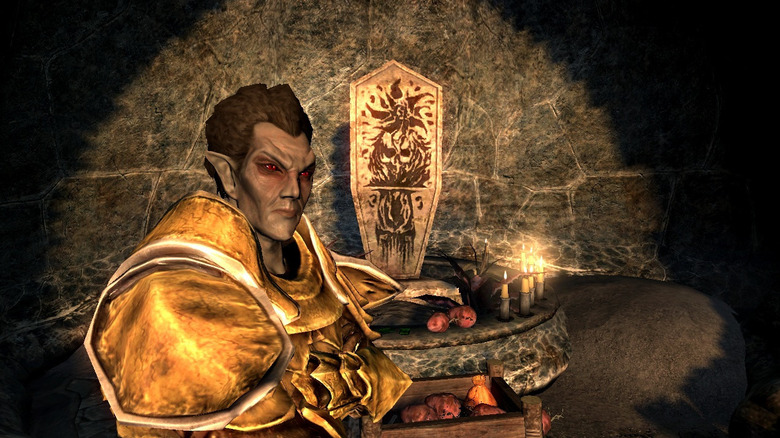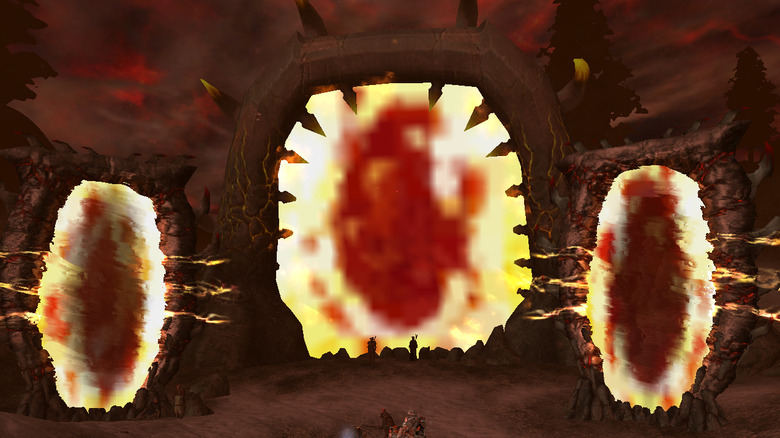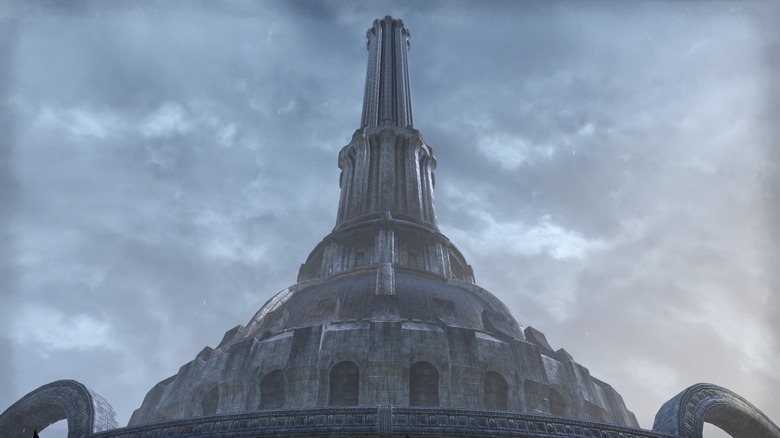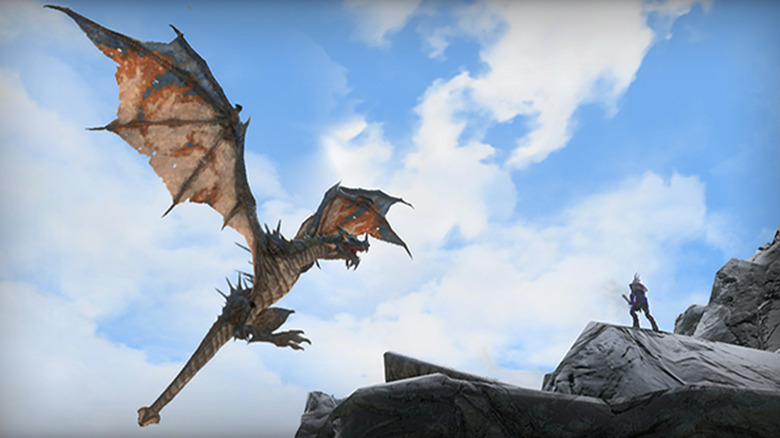The Entire Elder Scrolls Timeline Explained
"The Elder Scrolls" has frequently redefined what players expect from Western RPGs. Ever since the release of "The Elder Scrolls: Arena" in 1994, players have been treated with the vast, diverse world of Tamriel. That world has evolved and grown in scale, depth, and detail like few in the games industry. "Arena" allows players to travel across the entire continent of Tamriel, although most of the land is empty if players move too far from its four-hundred different cities. Later entries went on to feature a more focused scope that gives players a more detailed look at each of the individual provinces that make up the world of Tamriel.
This allowed each "Elder Scrolls" title to focus on detailing the cultures and histories of different corners of Tamriel. Over the years the series has continued to build out thousands of years of history for its different lands and species. While the expansive in-depth lore is fascinating for fans who have played through the series and pieced all of the in-game books and dialogue together, it can be a lot to catch up on for newer players. For those players — or for longtime fans that just need to freshen up on the important beats — here is the full timeline of "The Elder Scrolls" explained.
The Dawn Era - The Beginning of Time
Like most creation myths, the events of the Dawn Era vary greatly between each of Tamriel's races. Pinning down the exact happenings of the era is made even more difficult as there was no recordkeeping at all, and time somehow followed a nonlinear path that could split and reconnect seemingly at random. Despite this, each of the many different creation myths in "Elder Scrolls" share some commonalities that can be accepted as truth.
Each of the various religions and cultures in the series all agree that existence began when two entities, representing order and chaos, appeared in the void of nothingness. Afterward, they began to come into conflict with one another, the energy of which created the first realm of existence and a species known as the et'Ada that resided there. The et'Ada lived in relative peace until one of them, Lorkhan, wanted to make a new realm named Nirn. To do so Lorkhan tricked many of the et'Ada into helping him, causing the species to be split into two warring factions known as the Aedra and the Daedra. Each took their own realms of existence and have opposed one another ever since.
Early and Middle Merethic Era
The Mundus realm is split into a number of areas. Players will be most familiar with Nirn, as it is the realm of existence where the land of Tamriel exists. It was in the early Merethic Era where different tribes of beastfolk began to appear on Tamriel. The exact appearance of these beastfolk have been lost to time, but they went on to become the Khajiit and Argonians fans are familiar with, as well as a number of other races lost to time.
An unknown number of years later saw the Altmer, an ancient race of elves, arriving on the Tamriel as well. The Altmer were quick to push the beastfolk back, driving them to either live in the swamps and jungles of the continent or to flee for new lands entirely. The Aldmer then scattered across the land and began evolving into different types of elves such as the Dunmer, Orcs, and Ayelieds.
Late Merethic Era
The defining event of the late Merethic Era was the arrival of mankind on Tamriel. Humans believed to have come from across the Sea of Ghosts and quickly began dominating the northern coasts of Tamriel, especially in High Rock, Hammerfell, and Cyrodiil. From there, they derived their own Nordic text and language from that of the elvish races and claimed Skyrim for themselves. Years later, Alduin and his dragons claimed dominion over all of Nirn and the Humans fell into worshipping the dragons as gods. This led to the bloody Dragon War that led to most dragons being eradicated until the events of "Skyrim" in the fourth era.
During the Late Merethic Era, the Ayelid race also succumbed to widespread civil war between clans that wished to worship the more benevolent Aedra and those that enjoyed the decadence of the Daedra more. The period also saw the previously peaceful culture of the Iron Orcs having to shift towards smithing, training warriors, and mining in response to their sovereignty being threatened by the other races. This would go on to be a nearly constant aspect of their culture.
The 1st Era and the Camoran Dynasty - 1E 0
Proper timekeeping in Tamriel began when King Eplear founded the Camoran Dynasty in Valenwood. Eplear founded the template of using eras to denote larger shifts across Tamriel alongside counting the years since. The Camoran Dynasty was also one of the very first in all of Tamriel and was founded by uniting the scattered tribes of the Bosmer, or Wood Elves. This gave the dynasty the largest and most powerful unified military force in Tamriel's history and allowed the dynasty to quickly expand its political control and influence.
The Camoran Dynasty lasted for centuries thanks to the military prowess of Eplear's descendants. It would eventually face off against a number of other empires and dynasties, winning many of the conflicts and surviving those it lost wholly intact. The Dynasty eventually fell from a number of influences in 1E 2714 and tried returning to power a number of times throughout the years without success. However, descendants of the Camoran line have remained a thorn in the side of Valenwood's rulers ever since.
The Betrayal of the Snow Elves - 1E 139
The Snow Elves were once the dominant race in all of Skyrim during the Merethic Era. They were extremely progressive amongst the other early Elves and were said to have had an innate proficiency in magic that has never been replicated in any of the other races. When humans first appeared in Skyrim and began settling it, they were chased off by the Snow Elves in an event known as the Night of Tears. From there, the Snow elves attempted to eradicate the entire Human race, but accidentally let the Nord ruler Ysgramor escape.
Ysgramor's escape allowed him to gather an army known as the Five Hundred Companions that he used to mount a counter-attack on the Snow Elves in pursuit of their complete eradication. Their campaign was much more successful and brought the Snow Elves and their culture to the brink of extinction. To survive the Snow Elves sought refuge with the Dwemer, who agreed under the condition that they willingly consumed a toxic fungus to ensure that they could not turn on the Dwemer. Over the years the toxic fungus blinded the Snow Elves and turned them into the Falmer that were then enslaved by the Dwemer and still live in the caves of Skyrim. A few Snow Elves still exist in their proper form, but they are scattered and have joined society without their own culture, politics, or society.
The Cyrodilic Human Uprising - 1E 242
Up until this time, Cyrodill was still controlled by the Ayleids who built an empire on the backs of human slaves. This was all changed by the efforts of Alessia, who went on to be known as Saint Alessia. While Alessia's early life remains largely unknown, it is known that she prayed to the Aedra Akatosh, who bestowed upon her the Amulet of Kings, a handful of his blood, and guidance. The Amulet of Kings grew to be integral to Alessia's empire and was promised to keep the dragonfire, which was lit with Akatosh's blood, alight as long as someone of Alessia's line wore it, keeping the planes of Oblivion from invading Nirn.
From there, Alessia founded a holy city in Sancre Tor, upon which she declared an open rebellion of humans against the Ayleids. The campaign was a massive success and saw Alessia eventually claiming the White-Gold Tower that served as the Ayleids' capital. She then declared herself the ruler of a new empire and founded a religion of the Eight Divines, which later was increased to nine with the addition of Talos. This was the beginning of the Empire that is seen throughout "The Elder Scrolls" games, and forever changed the geopolitical state of all Tamriel.
The Red Mountain Dragon Break - 1E 700
The Battle of Red Mountain marked a long war between the Dwemer and Chimer, ancestors of the Dunmer, coming to a head. Some stories of the war claim that Nords, Orcs, and Khajiit were also present at the battle, but their possible involvement is not all that important. The war was sparked by word getting out that the Dwemer were working to build an entirely new god of their own. Many of the details regarding moments throughout the battle are unknown, but it had a massive effect on Tamriel that is still felt.
In the climax of the battle, a complicated event known as a dragon break occurred. Dragon breaks occur when there is an immense release of energy and power, sundering the flow of time and splitting it into multiple contradictory timelines that somehow reconnect, making all of the possible events literal. The Battle of Red Mountain is thought to be the first recorded dragon break and is widely thought to play some role in the almost complete disappearance of the Dwemer. It was following the battle that the Tribunal also gained access to the god being constructed by the Dwemer and were able to use its power to transcend to godhood themselves.
The Thrassian Plague - 1E 2200
The Thrassian Plague was one of the most devastating events in the entire first era and eventually killed more than half of Tamriel's population. The plague was given its name because it was believed to have originated on the distant continent of Thras, with many scholars even believing it to be a targeted attack on Tamriel. Those infected with the plague were terribly deformed until they were indistinguishable from one another. The plague also drove infected individuals to repeatedly drink until they vomited, eventually draining them of nutrients completely.
The Western coastline of Tamriel was particularly devastated by the plague as it is the closest to Thras. Out of the suspicion that the plague was an attack, a force known as the All Flags Navy was led by the King of Anvil, Bendu Olo, completely wiping the species out. The plague also weakened the Camoran Dynasty in Valenwood enough for the Empire to conquer it, as well as weakening the disparate tribes of Elsweyr enough for the Empire to claim that province as well in the following years.
The Guilds Act - 2E 321
While it is not the most exciting event in the timeline of "The Elder Scrolls," the Guilds Act is one of the most impactful, especially on later games in the series. The act was an edict from the Akaviri Potentate Versideu Shaie, who took transitory control of the Empire after its previous emperor was assassinated. The act founded sanctifying rules for guilds across all of Tamriel, leading to the creation of a number of influential guilds, such as the Fighters Guild, Mages Guild, Bards College, Thieves Guild, and a handful of others that have yet to make a full appearance in the video games.
The act had a sweeping effect across all of Tamriel by changing the economies and politics of provinces with the new power and influence of official guilds. It also helps unify many of the disparate cultures and peoples across the continent by giving individuals a unifying faction to support and serve under their own free will. However, the Guilds Act did not have as big of an impact on Skyrim as the other provinces. Thanks to the prior existence of both the Companions and the Winterhold Mages College, the province never received a form of the Fighters Guild or Mages Guild, respectively.
The Founding of the Dark Brotherhood - 2E 324-366
Before the Dark Brotherhood, there was the Morag Tong, a religious organization founded in Morrowind that celebrated murder. After the organization was found responsible for the assassination of Versideu Shaie, it was outlawed across Tamriel, eventually giving rise to the Dark Brotherhood. However, there are a few different explanations throughout the series for exactly how the Dark Brotherhood was founded.
The first is that the Dark Brotherhood split from the Morag Tong for religious reasons, as it worships Sithis, the entity of the void rather than the Daedric Prince Mephala. Whether this happened because of influence from Sithis or because the Morag Tong agreed to start worshipping the God-King Vivec remains unclear. Another explanation offered in the series is that the Dark Brotherhood split from the Thieves Guild after a member wanted to add murder to the guild's repertoire of services, That member then went on to become the guild's guiding Night Mother. Regardless of the guild's origins, the Dark Brotherhood has played a massive role in Tamriel ever since, even going so far as to occasionally assassinate the reigning emperor.
The Soulburst - 2E 578
The Soulburst was the first time the veil between Nirn and the realms of Oblivion was broken. The event was the consequence of Varen Aquilaros overthrowing the emperor of Cyrodiil. As Varen was not a descendant of Saint Alessia, he was convinced by one of the Five Companions, a necromancer named Mannimarco, that he could keep the dragonfire lit by slightly modifying the coronation ritual. However, Mannimarco corrupted the Amulet of Kings before the ritual and used it to instead create a massive explosion of magical energy that weakened the veil.
So much magical energy was generated by the ritual that a wave of it swept across the planet, afflicting magically sensitive individuals enough to outright kill or drive insane those nearest to them. With Nirn no longer protected from the realms of Oblivion, the Daedric Prince of Domination Molag Bal enacted a plan to conquer the dimension for himself. While Mogal Bal's scheme was eventually stopped, the event resulted in the Mages Guild being banned from the Imperial City, made it easier for necromancers to summon spirits and raise zombies, and led to an increase in the appearance of spirits and ghosts all around the world.
The Prophecy of the Nerevarine - 3E 427
When the Tribunal used the technology of the Dunmer to ascend to godhood, they went directly against the expressed wishes of the Daedric Prince Azura, the Goddess of dusk and dawn. Azura had told the Tribunal that the power should be destroyed so that it could not be used by anyone. Once she was defied, Azura made a prophecy that a hero named the Nerevarine would eventually rise in Morrowind and reveal the Tribunal for the false gods they were, bringing an end to their reign. However, her prophecy only came after she cursed the Chimer by giving them glowing red eyes and turning them into the Dunmer that fans of the series are now familiar with.
Many years later, Azura's prophecy came true in the form of the Nerevarine being reborn in Morrowind. The Nerevarine's actions across the province of Morrowind eventually lead to the deaths of both Sotha Sil and Almalexia while the final Tribunal member, Vivec, fled and is believed to have spent the rest of his days in isolated meditation. The fleeing of Vivec also allowed a meteor that he had stopped from hitting his city to finally crash into the surface of the world, destroying most of the region of Vvardenfell and killing countless people.
The Oblivion Crisis - 3E 433
It was not long after the fall of the Tribunal that Emperor Uriel Septim VII was assassinated at the hands of a cult known as the Mythic Dawn. The cult was led by Mankar Camoran, a descendant of the Camoran Dynasty who was a devout worshipper of the Daedric Prince Mehrunes Dagon. The assassination of Uriel Septim again disrupted the protections keeping Nirn from Oblivion, leading to a devastating invasion all across the known world.
The invasion was stopped by an individual known as the Hero of Kvatch as well as Uriel Septim's secret heir Martin Septim, although not until after a considerable amount of damage was done throughout Tamriel. Martin Septim also had to give his life to send Mahrunes Dagon back to Oblivion and is petrified into the statue of a massive dragon in the temple district of the Imperial City.
The Great War - 4E 175
The Oblivion Crisis brought an end to the Third Era and threw Tamriel into chaos. Following the absolute failure of the Empire to protect its many provinces, a desire to secede from the empire quickly swept across Tamriel. The biggest faction to rise from the Oblivion Crisis' destruction was the Third Aldmeri Dominion. Led by the Thalmore, the Aldmeri Dominion unified western provinces and led them in a war against the Empire.
Because of how weakened the Empire was by dealing with the Oblivion Crisis, the majority of the Great War was fought on Empire soil in both Cyrodiil and Hammerfell. The Empire originally surrendered after the sacking of the Imperial City, leading to the signing of the White-Gold Concordat. The treaty was seen as a betrayal by many remaining imperial provinces as it outlawed the worship of Talos and gave the Thalmor an extremely high influence on the Empire.
The Dragon Crisis - 4E 201
While the signing of the White-Gold Concordat sparked the secession of more provinces from the Empire, as well as the Civil War in Skyrim, it also coincided with the start of the Dragon Crisis. Following the words of an ancient prophecy from the Merethic Era, the Dragon Crisis was ignited by the return of Alduin, a dragon and Nordic god of destruction. Once Alduin was able to return to Nirn, he quickly set about resurrecting dragons killed under his command in the Dragon War.
The return of the dragons coincided with the reveal of a new Dragonborn, the first in hundreds of years. The Dragonborn then worked with the last remnants of the Blades to stop Alduin's plan to reclaim control over Skyrim and enslave its people. However, rather than fully defeating Alduin, they were only able to weaken him enough to send him to Sovngarde, the afterlife of the Nords.

